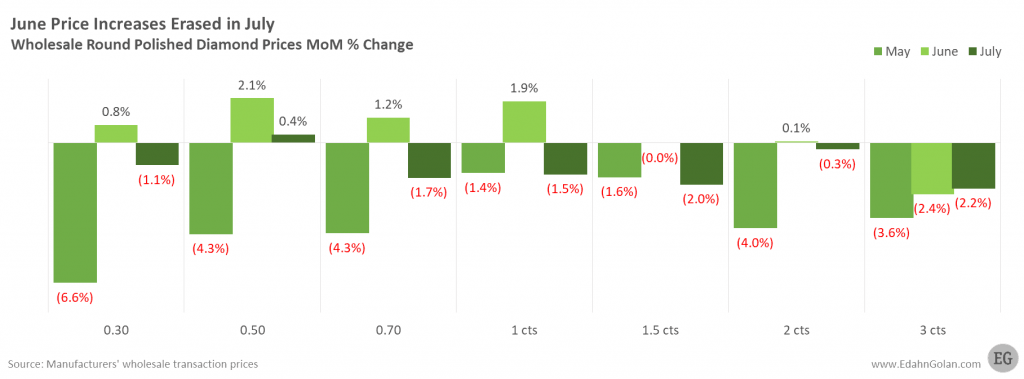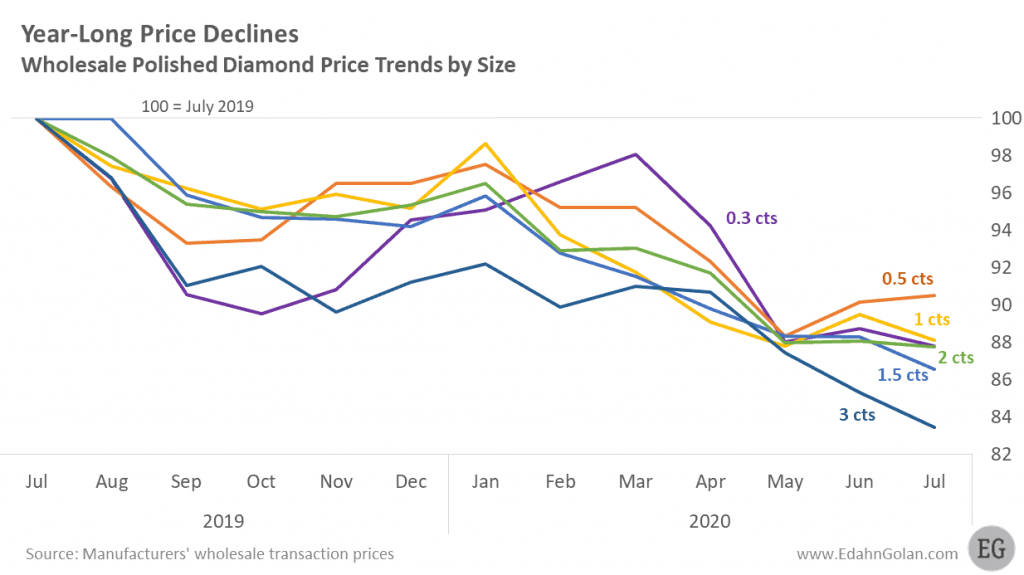The diamond business has continued to absorb the repercussions of the global pandemic. Polished diamond wholesale prices, after a small improvement in June, continued to mostly slide in July. This coincides with an ongoing decline in jewelry share of wallet.
The ensuing economic meltdown, caused mainly by a vicious drop in retail sales, is hurting the diamond industry from top to bottom.
Diamond business supplying only against known demand
Retail demand for polished diamonds is razor-sharp specific. Retailers are willing to order goods from their vendors only against consumer orders. There are practically no opportunity purchase and inventory replenishments. This focuses demand in the wholesale sector to the point of creating deep shortages in those specific areas. And these shortages, ironically, drive up diamond prices in a time when overall demand is especially low and inventories relatively high.
Polished diamond prices keep sliding
Month over month, wholesale polished diamond prices declined an estimated 1.4% in July. Since February, prices declined on average by 1.6% every month. Is the price decline easing? It’s too early to say.
On a month-over-month basis, wholesale diamond prices declined in every single key category, with one exception: half-carat goods rose a small 0.4%. This is the second month in a row that 0.5-carats posted a price increase after rising 2.1% in June.

The decline in diamond prices in July was somewhat surprising after the small revival in prices in June. The reversal in price movement for 0.30-carat, 0.70-carat, and 1-carat round diamonds is not a positive sign. The hope in the diamond market was that prices had hit bottom and would mostly rise from there on.
However, this was not the case, and at this point, prices are even expected to decline a little more. Historically, consumer demand tends to rise in August due to tourism traffic. In a post-COVID-19 world, international summer travel is down to a record low and, with it, the tourist expenditures that accompany it. Without tourists shopping in the US, total retail sales are expected to shrink further this year.
Long-term diamond price trend: downward
Much of the blame for the price declines should be placed on the pandemic. However, COVID impacted retail sales only starting in March, coming into full effect in April. With polished diamond prices falling for much longer than this, we can’t place the full blame on lockdowns, social distancing, and fears of getting infected with the virus.

As seen in 2015 and again in 2017, wholesale polished diamond prices have been declining on a year-over-year basis for a stretch lasting more than a year. In the current stretch, wholesale diamond prices of most items have been declining since February 2019.
Underlying diamond industry issues
The long-term price declines were only exasperated by the outbreak. The underlying issues that plagued prices prior to March 2020, and which hurt the diamond business from every possible direction, are still very much there.
The lack of attractive marketing, slow response to the shift in consumer demand, and lack of attentive care of consumers that resulted in growing interest in lab-grown are some of the underlying factors. Diamond traders may blame lack of financing, high rough diamond prices, or limited government support, but that is not what is stalling the diamond business.
At its most fundamental, diamonds are a consumer product. If the diamond industry forgets to tend to consumers, all the bank financing and favorable tax regimes won’t help the diamond business one bit.
Photo © De Beers.

